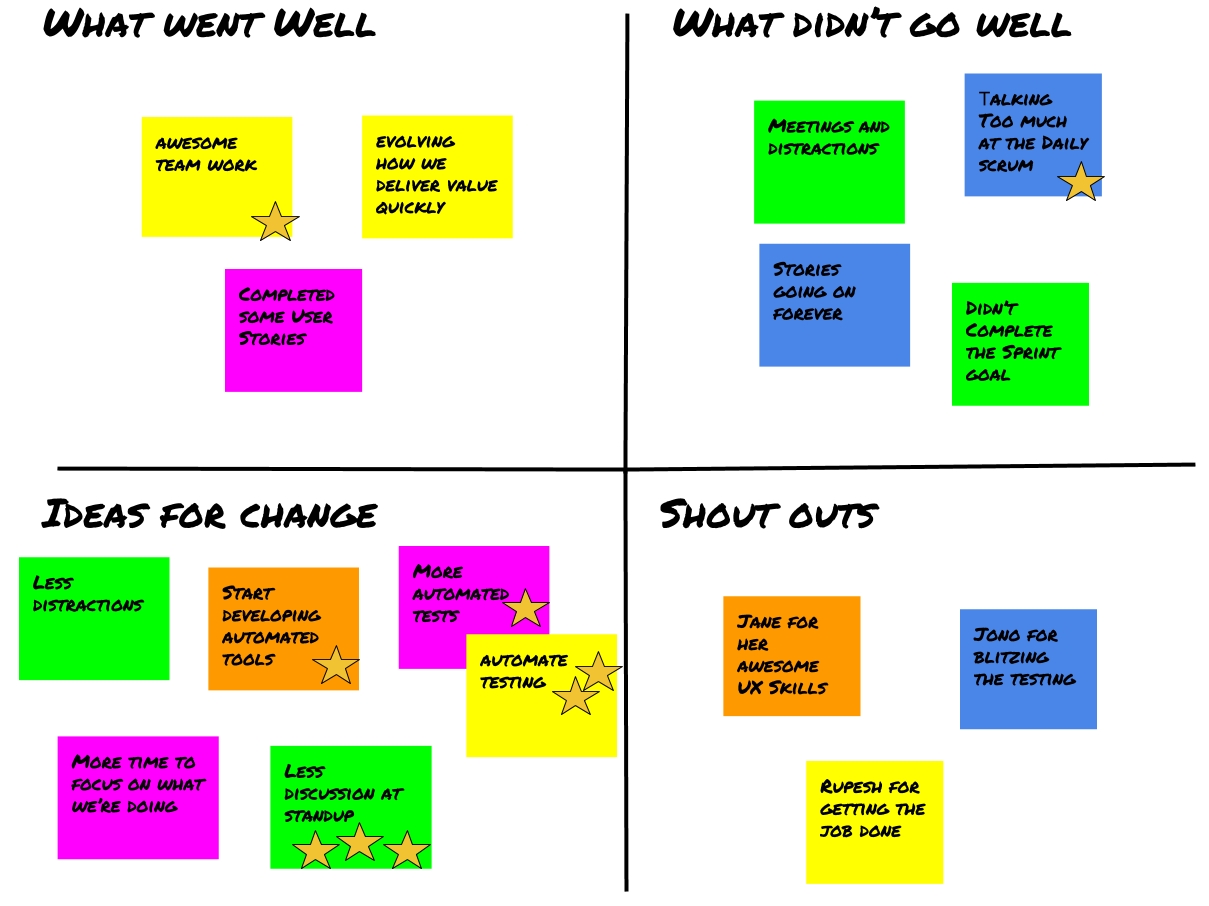The Sprint Retrospective is an opportunity for the team to reflect on their first Sprint. You should look at what went well, what didn't go so well, and what can be improved.
This is how you set it up:
Setup: A large table that the whole team can fit comfortably around
Attendees: The Scrum team
Time-box: 3 hours for 1-month Sprints; for shorter Sprints, the event is usually shorter
Your Scrum Master facilitates the Sprint Retrospective. There is a degree of preparation required to run a retrospective, and so we recommend heeding the following format:
- Setting the stage: The Scrum Master presents some facts and figures from the last Sprint. They should aim to paint a picture of what happened. Did the team meet its Sprint Goal? What was the team's velocity? How did the Sprint Burndown look?
- Gather data: At this stage, the team needs to collect more data about the Sprint. On the whiteboard, the Scrum Master draws quadrants for the four following categories:
- What went well?
- What didn't go well?
- Ideas for change
- Shout outs (thanking team members for their work)
Using post-it notes and a sharpie, write as many post-its as you can think of (one item per post-it) that fit into either one of those four categories. The Scrum Master will keep the time-box, and the team should work silently. They can then place the post-it notes on the board as they go or wait until the time-box is up.
Once done, you should end up with something like the following:

- Generating insights: At this point, you should examine what everyone has written as a group. You can see, for example, that three people have mentioned automated testing in the 'Ideas' quadrant. You can also see that the team agrees that there are too many distractions (referred to in IDEAS FOR CHANGE and WHAT DIDN'T GO WELL).
- Decide what to do: Next, you need to decide how to improve the next Sprint for the better. For this, you can either take an item from 'What went well' and decide how to amplify it. You could also decide how you can minimize an issue from WHAT DIDN'T GO WELL. You could also work out how to implement an IDEA FOR CHANGE. Consider the items that will generate the most value.
The Scrum Master will ask the team to vote on what needs to be done. Team members get three votes each and each vote must be written on one post-it note.
In the following instance, we use gold stars to vote:

As you can see, AUTOMATED TESTS and LESS DISCUSSION AT STANDUP get three votes each in total.
So, now it's time to create actions for each of these. Aim to take two to three actions from each retrospective, and no more. You're aiming for small incremental changes that can be introduced with each Sprint. Your goal should be to make your actions SMART: Smart, Measurable, Agreed upon, Realistic, and Time-based.
Here are some suggested actions that fit the SMART approach:
-
- ACTION: Less discussion at the Daily Scrum
WHAT: Set up an 'After Party Zone' on the Scrum Board. Any topics for discussion should be recorded there so that the team can talk about them in the After Party.
WHO: The Scrum Master will set up the After Party Zone area on the board and record any relevant topics.
WHEN: At subsequent Daily Scrums.
-
- ACTION: Automated testing.
WHAT: Implement a test framework when working on the next story to facilitate learning.
WHO: Jono and Rupesh.
WHEN: The next Sprint.
- Close: With the retrospective actions complete, the Scrum Master closes the retrospective. They ask each team member to give one sentence to describe their experience of the retrospective.
The Scrum Master will then place the retrospective action items on the team's Scrum Board to be worked on during the next Sprint.
